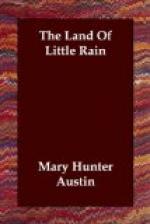From the height of a horse you look down to clean spaces in a shifty yellow soil, bare to the eye as a newly sanded floor. Then as soon as ever the hill shadows begin to swell out from the sidelong ranges, come little flakes of whiteness fluttering at the edge of the sand. By dusk there are tiny drifts in the lee of every strong shrub, rosy-tipped corollas as riotous in the sliding mesa wind as if they were real flakes shaken out of a cloud, not sprung from the ground on wiry three-inch stems. They keep awake all night, and all the air is heavy and musky sweet because of them.
Farther south on the trail there will be poppies meeting ankle deep, and singly, peacock-painted bubbles of calochortus blown out at the tops of tall stems. But before the season is in tune for the gayer blossoms the best display of color is in the lupin wash. There is always a lupin wash somewhere on a mesa trail,—a broad, shallow, cobble-paved sink of vanished waters, where the hummocks of Lupinus ornatus run a delicate gamut from silvery green of spring to silvery white of winter foliage. They look in fullest leaf, except for color, most like the huddled huts of the campoodie, and the largest of them might be a man’s length in diameter. In their season, which is after the gilias are at their best, and before the larkspurs are ripe for pollen gathering, every terminal whorl of the lupin sends up its blossom stalk, not holding any constant blue, but paling and purpling to guide the friendly bee to virginal honey sips, or away from the perfected and depleted flower. The length of the blossom stalk conforms to the rounded contour of the plant, and of these there will be a million moving indescribably in the airy current that flows down the swale of the wash.




